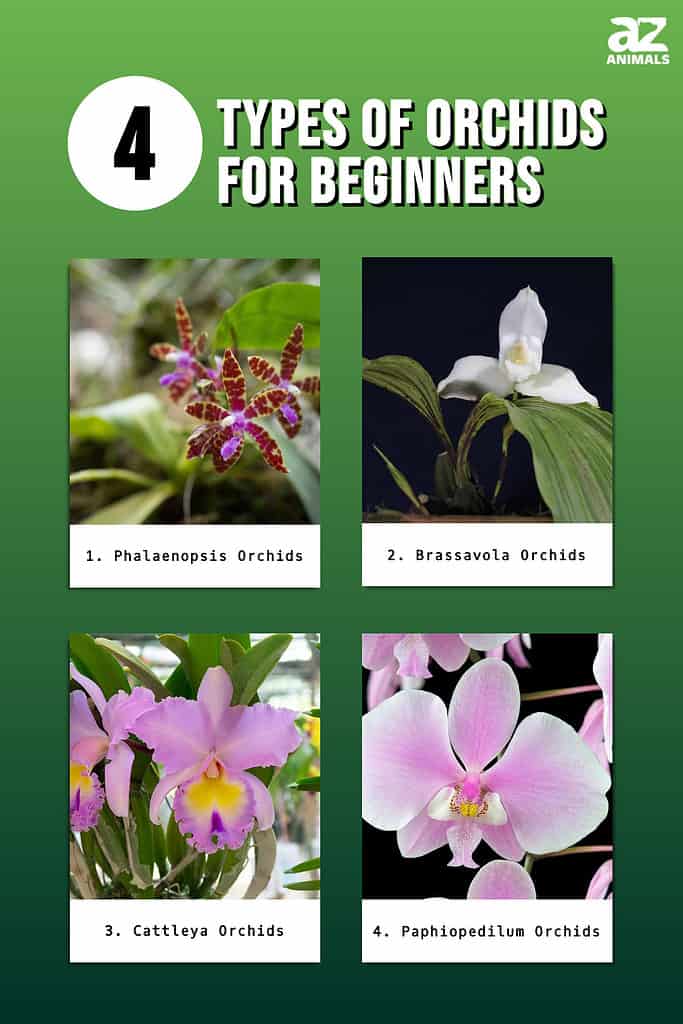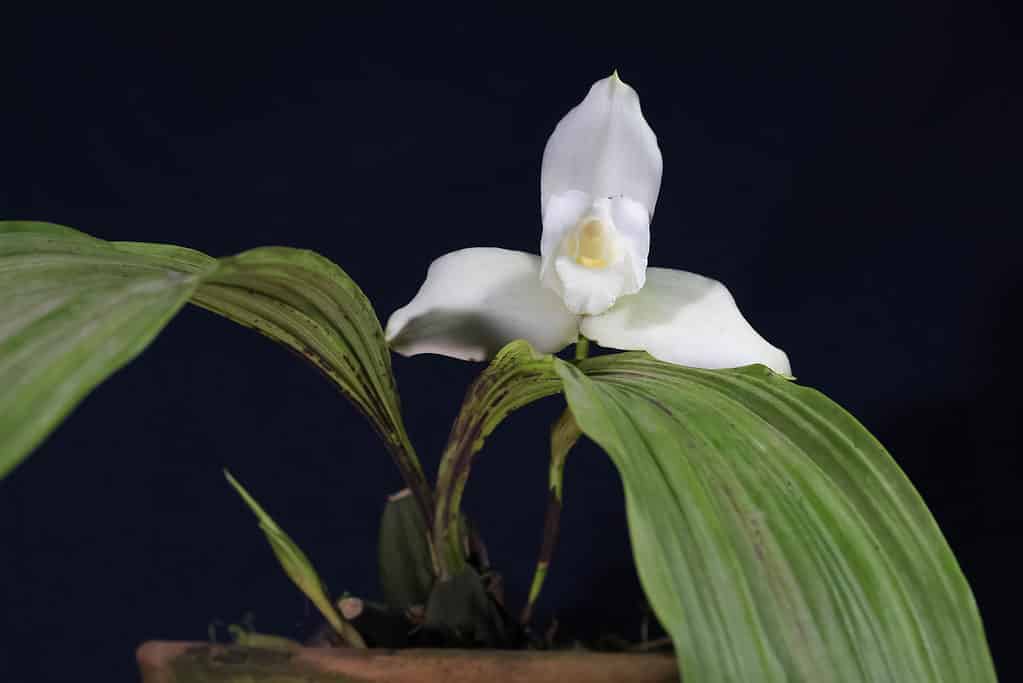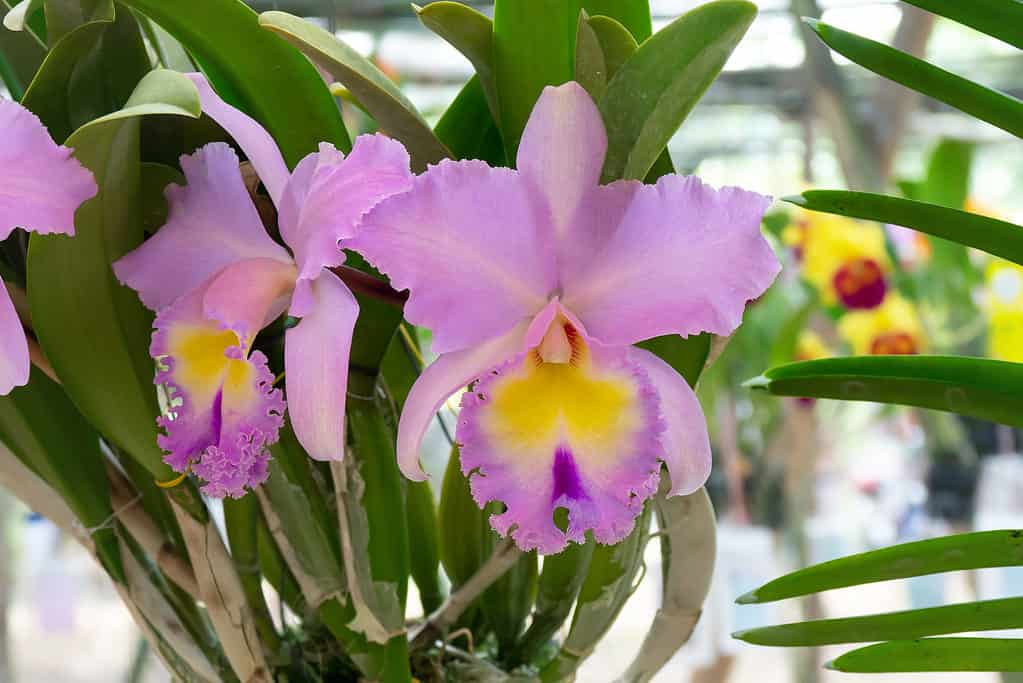Looking to get started in the fanciful world of orchid growing? You may be quite intimidated as orchids tend to have a reputation as being difficult to cultivate. While this may be true for several species, you’ll find that some species and genera of orchids exist that are notably beginner-friendly.
In this guide, we’ll briefly cover the botanical classification of orchids and then discuss four genera of beginner-friendly orchids that contain species that are mostly easy to grow. Whether you’re looking to grow orchids as houseplants, in temperate outdoor gardens, or for lovely cut flowers, you will surely find a suitable species for your skill level.

So, without further ado, let’s dive into this exciting topic!
Orchids: Botanical Classification

The pink
butterfly
orchid often attracts hummingbirds and butterflies.
©This image was originally posted to Flickr by Alastair Rae at https://www.flickr.com/photos/55663585@N00/172134789 – License
When starting orchid growing, it’s highly recommended that you learn about the Orchidaceae family in general. You can learn so much about orchid care by understanding the evolution and diversity of this stunning botanical family.
These magnificent plants have been evolving for a little over 100 million years. Starting out as terrestrial flowering plants, they eventually began climbing the trunks of trees, attaching themselves non-parasitically to bark (epiphytes). They thrived in this largely unfilled niche, and by 35 million years ago, most orchid species were epiphytes. In the present day, about 80% of orchids thrive as epiphytes.
Their success in growing in the ground (terrestrial), attached to bark (epiphytes), and clinging to rocks (lithophytes) has helped them successfully spread to every continent on Earth except Antarctica. Today, there are about 880 genera of orchids and nearly 30,000 species, making Orchidaceae the second-largest family of flowering plants.
4 Genera of Beginner-Friendly Orchids
With almost 30,000 naturally-occurring species and thousands more cultivars, it’s no wonder there are beginner-friendly varieties available to welcome you into the wonderful world of orchid growing. You’ll find that genera of orchids that thrive in a generally uniform, year-round mild climate are excellent candidates for houseplants. At the same time, those that need a cool or cold season to flower are excellent prospects for outdoor temperate growers.
We’ve listed four genera of orchids widely accepted as beginner-friendly. By listing by genus rather than species, you’ll be able to choose more options and find the best species for your growing environment and aesthetic preference.
Our four easy-to-grow genera picks are:
- Phalaenopsis Orchids (Phalaenopsis spp.)
- Brassavola Orchids (Brassavola spp.)
- Cattleya Orchids (Cattleya spp.)
- Paphiopedilum Orchids (Paphiopedilum spp.)
Below, we’ll introduce the four genera, their native ranges and growing conditions, and general care guidelines for each genus. For each genus, we’ll also provide five recommendations of beginner-friendly orchid species to consider.
1. Phalaenopsis Orchids (Phalaenopsis spp.)

Native to the lowland Sulu Archipelago region of the Philippines, Bastian’s phalaenopsis is an elegant, tropical epiphytic orchid.
©Daniel VG/Shutterstock.com
Ask master orchid gardeners what orchid genus is the most beginner friendly, and the consensus almost assuredly would be Phalaenopsis. Phalaenopsis orchids, or phals, are readily available, thrive as houseplants, and are highly sought after for their long blooming times and tolerant nature.
According to the American Orchid Society, the genus is divided into 63 species, 7 natural hybrids, and thousands of cultivated hybrids. Some particularly popular species include Phal. schilleriana, Phal. equestris, Phal. amabilis, Phal. bellina, and Phal. lueddemanniana.
Native Range and Growing Conditions
Native to tropical regions of Southeast Asia, parts of Australia, and the Philippines, most phals are warm-to-hot growing epiphytes. They grow on the barks of trees, typically in lower altitude regions, and generally under uniform year-round temperatures.
In their natural settings, these plants experience wet-dry seasonal variation with heavy rain in the spring and summer and a winter dry season. However, because the native range is lowland tropical, the air is always humid regardless of the season.
Growing in dense tropical forests, phals usually prefer moderate indirect light and don’t fare well growing in direct sunlight.
Beginner-Friendly Orchids: General Phalaenopsis Care Requirements
One reason orchids in the Phalaenopsis genus grow so well as houseplants is due to their mild, uniform year-round temperature requirements. You can easily recreate this growing environment in your home. The general recommended temperature range for this genus of orchids is a low of 65 degrees Fahrenheit at night and a high of 80 degrees during the day.
You can also keep the humidity range uniform year-round, although it’s best practice to keep the air more humid during the day than at night. About 70% during the day and 50-60% at night is ideal. Consistent air movement is crucial, especially when the humidity is moderate-to-high. Circulator fans are a great tool to ensure this air movement.
Remember that the orchids in this genus are epiphytes, so they need a soil-less potting mix. They aren’t too picky as long as the medium provides aeration and good drainage. A fir bark-based potting mix is ideal for phals. You can use a balanced orchid fertilizer for this plant.
2. Brassavola Orchids (Brassavola spp.)

White nun orchids’ common name is la monja blanca, Spanish for the white nun.
©Arielvelasquez0896/Shutterstock.com
Another popular genus for beginner orchid growers is Brassavola. This small but well-loved genus contains about 20 species and many more cultivars. This genus produces showy, long-flowering, and often quite fragrant blooms. Care requirements are quite simple and achievable for beginner growers.
The most popular species are Brassavola nodosa, B. cordata, B. cucullata, B. cebolleta, and B. acaulis. B. nodosa, commonly named the lady of the night orchid, is especially sought after and often found in beginner to advanced grower collections.
Native Range and Growing Conditions
Native to the coastal plains and lowland tropical forests of Central and South America, brassavolas are warm-to-hot growing epiphytes that all produce lovely white flowers. Rather than attract their night-flying moth pollinators with striking colors or cleverly deceptive shapes, these orchids produce strong, alluring fragrances. Their ghostly white blooms and night-released citrus-scented fragrances attract suitable night-flying moth pollinators, such as sphynx moths.
While they mostly grow at epiphytes, you can sometimes find orchids in the Brassavola genus attached to rocky outcrops and cliffs along the coastal shore. Light exposure depends on their range of habitats, but they tend to thrive in very bright, indirect sunlight.
Like orchids in the Phalaenopsis genus, brassavolas thrive in mild to warm year-round temperatures. Typically, these plants experience wet summers and dry winters. The length of the dry season varies significantly by region and ranges from 1-6 months.
Beginner-Friendly Orchids: General Brassavola Care Requirements
This genus also tends to thrive as houseplants year-round or taken inside once outside temperatures dip below 60 degrees. In general, brassavolas thrive in temperatures between 60-85 degrees Fahrenheit with ideal night temps being about 10-15 degrees cooler than daytime highs.
They love moderate to high humidity levels with lots of air movement. An ideal humidity range is 50-70%, with higher humidity levels in the summer to match their native fall-winter dry season. However, even in the dry season, these plants don’t tolerate dying out because they receive moisture through the air humidity, moisture retained in moss on the trees and rocks they cling to, and lots of morning dew.
Water heavily during their active growing phase from late winter-summer and cut back in the late fall-winter, but don’t allow the growing substrate to fully dry out. Avoid soggy roots as well when watering more regularly.
Suitable growing mediums need to be fast-draining and well-aerated to compensate for the heavy watering required in the summer. Medium-to-large-sized fir bark, cork nuggets, and tree-fern fiber are all excellent choices. A balanced, water-soluble orchid fertilizer applied weekly at 1/4-1/2 the dosage is recommended during active growth. This genus does not appreciate a lot of mineral buildup, so flush the substrate every few weeks with running water. You can cut back to fertilizing once per month or eliminate feeding during late fall-mid winter.
Bright, indirect lighting is ideal for brassavolas. Take care to ensure light levels are especially high during the winter months. If light levels aren’t high enough, your plant won’t be able to maintain nutrient levels during dormancy, and it likely won’t have the energy required to bloom.
3. Cattleya Orchids (Cattleya spp.)

Cattleya Orchids.
©iStock.com/wisan224
Once considered the queen of all orchids, cattleyas are stunning bloomers, and most species are considered beginner-friendly. Currently, around 120 species of orchids in the Cattleya genus are recognized by the World Checklist of Selected Plant Families. In addition to the species, many natural varieties, hybrids, and cultivars exist.
Some of the most popular cattleya species for beginner growers include Cattleya skinneri, C. bicolor, C. labiata, C. mossiae, and C. gaskelliana.
Native Range and Growing Conditions
Cattleyas are tropical epiphytes (and less commonly lithophytes) that hail from tropical regions of Central and South America and produce wonderfully showy and often quite fragrant blooms. These plants develop one or more pseudobulbs that store nutrients and water, allowing them to survive among the topmost branches of trees where the air is less humid. As long as they have sufficient water storage, cattleyas can be quite drought tolerant.
They also survive low light conditions fairly well, but you will find they only flower in bright light. While they can survive in lower light or more arid conditions, they thrive best growing near water sources with high humidity and in bright, indirect sunlight.
Beginner-Friendly Orchids: Cattleyas General Care Requirements
Cattleyas are considered one of the easiest orchid genera to grow, but you must tailor your care to the specific cattleya species. Care requirements will depend on how many pseudobulbs the species creates and what habitat it naturally grows in (ex., high in the tree canopy, in gullies near streams, or rocky outcrops?)
These orchids tend to thrive in intermediate to warm conditions. Amazonian species such as C. luteola, C. eldorado, and C. violacea grow under warmer conditions. Most species will thrive in intermediate to bright, indirect light. Like all epiphytic orchids, cattleyas require clean, consistent air movement.
Generally, cattleyas like to dry out between watering with water restrictions during fall and winter. However, you’ll find that the Amazonian species listed above tend to prefer a more consistent watering schedule. Humidity levels should be at their highest, between 65-85%, during their active growing phase. For the rest of the year, 50% average humidity is acceptable.
You should succeed with light weekly feeding of a balanced, water-soluble orchid fertilizer. During fall and winter, you can restrict or remove fertilizing.
4. Paphiopedilum Orchids (Paphiopedilum spp.)

Close-up of Schiller’s moth orchid,
Phalaenopsis schilleriana.
©PAUL ATKINSON/Shutterstock.com
Our final suggestion for beginner-friendly orchids is Paphiopedilums, or lady’s slipper orchids, a genus of semi-terrestrial orchids that produce eye-catching blooms with a pouch or slipper-like labellums (lower modified petal, or lip). The pouched labellum is a crucial pollination feature for this genus of plants. When pollinators, often bees or wasps, land on the edge of the labellum and begin probing for food, they eventually slip or travel into the pouch of the labellum. Once inside, the only way to exist requires them to brush again sticky pollen, which attaches to the pollinator and is transferred to either a new flower or the stigma of a self-pollinating plant.
It’s important to note that the common name, lady slipper’s orchid, applies to more than just the Paphiopedilum genus. These orchids belong to the Cypripedioideae subfamily, which includes five genera of slipper orchids.
To distinguish orchids in this genus from other lady’s slipper orchids, some growers call these orchids paphs or paph slipper orchids. These plants are well-loved for their exciting blooms and generally easy-to-care-for nature. Some particularly beloved and beginner-friendly species include Paphiopedilum niveum, Paph. venustum, Paph. delophyllum, Paph. delenatii, and Paph. callosum.
Native Range and Growing Conditions
Cool-to-warm growing semi-terrestrial orchids, paphs are native to temperate regions of Southeast Asia, southern China, and India. They are considered semi-terrestrial as they typically grow in the leaf litter collected in rock crevices rather than directly in the soil.
Paphs are traditionally separated into two groups based on temperature. Species that feature mottled leaves, such as Paph. callosum, prefer warmer temperatures than species with monochromatic green leaves, such as Paph. wilhelminiae. Most cool-growing species are native to high-altitude areas of India. You’ll find that the easiest-to-grow paphs fall in the warm-growing, mottled-leaf-producing group.
Beginner-Friendly Orchids: Paphiopedilums General Care Requirements
All paphs prefer to grow in moderate, indirect light. Exposure to direct sunlight can quickly lead to leaf burn. You’ll often notice the tips of the leaves turning red if the plant’s sunlight conditions are too bright.
The mottle-leaved species are particularly well-suited to beginner growers and year-round life as a houseplant. They also have the added benefit of producing stunning, pouched blooms and quite interesting foliage. The temperature range for warm-growing paphs is ideally 60-65 degrees Fahrenheit at night and between 75-85 degrees during the day. Note that while this range is ideal, these plants are rather temperature-hardy. They are known to survive ranges down to the 40s and up to 95 degrees Fahrenheit.
Orchids in the Paphiopedilum genus do not produce pseudobulbs, so they require consistent watering as they cannot long-term store nutrients or water. Year-round, water these plants to keep the growing medium moist but never soggy. Moderate humidity between 40-50% is ideal.
You can pot these plants in various mixes if moisture retention and excellent drainage are achieved. Fine-to-medium grain fir bark-based mixes with perlite, coarse sand, and sphagnum moss are particularly popular as the moss promotes moisture retention while the sand and perlite aid in excess water drainage.
High-nitrogen orchid fertilizers are recommended if you do pot in a fir bark mix. You can apply at 1/4 strength every week or 1/2 strength every two weeks during the growing season with monthly water flushing. During the winter, cut back feedings to once per month to avoid root burn.
The photo featured at the top of this post is © Summer 1810/Shutterstock.com
Thank you for reading! Have some feedback for us? Contact the AZ Animals editorial team.






